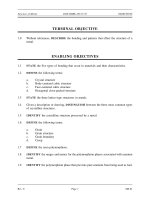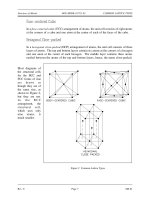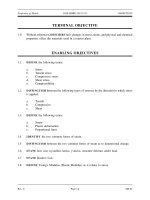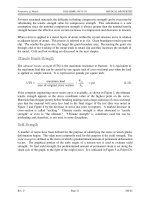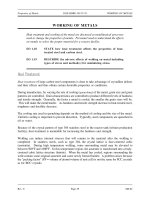Material Science_ Vol 2 of 2 - US DOE (1993) WW part 8 pot
Bạn đang xem bản rút gọn của tài liệu. Xem và tải ngay bản đầy đủ của tài liệu tại đây (36.97 KB, 8 trang )
Plant Materials DOE-HDBK-1017/2-93 OBJECTIVES
TERMINAL OBJECTIVE
1.0 Without references, DESCRIBE the considerations commonly used when selecting
material for use in a reactor plant.
ENABLING OBJECTIVES
1.1 DEFINE the following terms:
a. Machinability
b. Formability
c. Stability
d. Fabricability
1.2 IDENTIFY the importance of a material property and its application in a reactor plant.
1.3 LIST the four radioactive materials that fission by thermal neutrons and are used as
reactor fuels.
1.4 STATE the four considerations in selecting fuel material and the desired effect on the
nuclear properties of the selected fuel material.
1.5 STATE the four major characteristics necessary in a material used for fuel cladding.
1.6 IDENTIFY the four materials suitable for use as fuel cladding material and their
applications.
1.7 STATE the purpose of a reflector.
1.8 LIST the five essential requirements for reflector material in a thermal reactor.
1.9 STATE the five common poisons used as control rod material.
1.10 IDENTIFY the advantage(s) and/or disadvantages of the five common poisons used as
control rod material.
Rev. 0 Page vii MS-05
OBJECTIVES DOE-HDBK-1017/2-93 Plant Materials
ENABLING OBJECTIVES (Cont.)
1.11 DESCRIBE the requirements of a material used to shield against the following types of
radiation:
a. Beta
b. Gamma
c. High energy neutron
d. Low energy neutron
1.12 STATE the nuclear reactor core problems and causes associated with the following:
a. Pellet-cladding interaction
b. Fuel densification
c. Fuel cladding embrittlement
d. Fuel burnup and fission product swelling
1.13 STATE the measures taken to counteract or minimize the effects of the following:
a. Pellet-cladding interaction
b. Fuel densification
c. Fuel cladding embrittlement
d. Fission product swelling of a fuel element
1.14 DEFINE the following terms:
a. Fatigue failure
b. Work hardening
c. Creep
1.15 STATE the measures taken to counteract or minimize the effects of the following:
a. Fatigue failure
b. Work hardening
c. Creep
MS-05 Page viii Rev. 0
Plant Materials DOE-HDBK-1017/2-93 OBJECTIVES
ENABLING OBJECTIVES (Cont.)
1.16 STATE how the following types of radiation interact with metals:
a. Gamma
b. Alpha
c. Beta
d. Fast neutron
e. Slow neutron
1.17 DEFINE the following terms:
a. Knock-on
b. Vacancy
c. Interstitial
1.18 DEFINE the following terms:
a. Thermal spike
b. Displacement spike
1.19 STATE the effect a large number of displacement spikes has on the properties of a metal.
1.20 DESCRIBE how the emission of radiation can cause dislocation of the atom emitting the
radiation.
1.21 STATE the two effects on a crystalline structure resulting from the capture of a neutron.
1.22 STATE how thermal neutrons can produce atomic displacements.
1.23 STATE how gamma and beta radiation effect organic materials.
1.24 IDENTIFY the change in organic compounds due to radiation.
a. Nylon
b. High-density polyethylene marlex 50
c. Rubber
1.25 IDENTIFY the chemical bond with the least resistance to radiation.
1.26 DEFINE the term polymerization.
Rev. 0 Page ix MS-05
OBJECTIVES DOE-HDBK-1017/2-93 Plant Materials
ENABLING OBJECTIVES (Cont.)
1.27 STATE the applications and the property that makes aluminum desirable in reactors
operating at:
a. Low kilowatt power
b. Low temperature ranges
c. Moderate temperature range
1.28 STATE why aluminum is undesirable in high temperature power reactors.
MS-05 Page x Rev. 0
DOE-HDBK-1017/2-93
Plant Materials PROPERTIES CONSIDERED WHEN SELECTING MATERIALS
PROPERTIES CONSIDERED
WHEN SELECTING MATERIALS
There are many different kinds of materials used in the construction of a nuclear
facility. Once constructed, these materials are subjected to environments and
operating conditions that may lead to material problems. This chapter discusses
considerations for selection and application of plant materials.
EO 1.1 DEFINE the following terms:
a. Machinability
b. Formability
c. Stability
d. Fabricability
EO 1.2 IDENTIFY the importance of a material property and its
application in a reactor plant.
Overview
During the selection and application of materials used for construction of a nuclear facility, many
different material properties and factors must be considered depending upon the requirements for
each specific application. Generally, these consist of both non-fuel reactor materials, used for
structural and component construction, and fuel materials. This chapter discusses some of the
considerations used in the selection process for plant materials including material properties, fuel,
fuel cladding, reflector material, control materials, and shielding materials.
Material Properties
The following properties are considered when selecting materials that are to be used in the
construction of nuclear facilities.
Machinability
Components may be formed by removing metal "chips" by mechanical deformation. This
process is referred to as machining.
Machinability describes how a metal reacts to
mechanical deformation by removing chips, with respect to the amount of metal
effectively removed and the surface finish attainable. The mechanical properties of the
metal will be the factors that influence the machinability of a metal.
Many components used in nuclear reactor construction use machined parts that require
very close tolerances and very smooth surfaces. Thus, machinability becomes an
important consideration when choosing materials for manufacturing these parts.
Rev. 0 Page 1 MS-05
DOE-HDBK-1017/2-93
PROPERTIES CONSIDERED WHEN SELECTING MATERIALS Plant Materials
Formability
Components may be formed by processes such as rolling or bending, which may cause
some parts of the metal to expand more than others.
Formability of a material is its
ability to withstand peripheral expansion without failure or the capacity of the material
to be to manufactured into the final required shape. This becomes important in selecting
materials that have to be made into specific shapes by such means as rolling or bending
and still retain their required strength.
Ductility
Ductility is the plastic response to tensile force. Plastic response, or plasticity, is
particularly important when a material is to be formed by causing the material to flow
during the manufacture of a component. It also becomes important in components that
are subject to tension and compression, at every temperature between the lowest service
temperature and the highest service temperature. Ductility is essential for steels used in
construction of reactor pressure vessels. Ductility is required because the vessel is
subjected to pressure and temperature stresses that must be carefully controlled to
preclude brittle fracture. Brittle fracture is discussed in more detail in Module 4, Brittle
Fracture.
Stability
Stability of a material refers to its mechanical and chemical inertness under the conditions to
which it will be subjected. Nuclear plants have a variety of environments to which materials
are subjected. Some of these environments, such as high temperatures, high acid, high
radiation, and high pressure, can be considered extreme and harsh; therefore, the stability of
the materials selected for service in these areas is a major consideration.
Corrosion mechanisms can become very damaging if not controlled. They are identified
in Module 2, Properties of Metals. High corrosion resistance is desirable in reactor
systems because low corrosion resistance leads to increased production of corrosion
products that may be transported through the core. These products become irradiated and
contaminate the entire system. This contamination contributes to high radiation levels after
shutdown. For these reasons, corrosion resistant materials are specially chosen for use in
the primary and secondary coolant systems.
Availability
The availability of a material used in the construction of nuclear plants refers to the ease
with which a material can be obtained and its cost.
MS-05 Page 2 Rev. 0
DOE-HDBK-1017/2-93
Plant Materials PROPERTIES CONSIDERED WHEN SELECTING MATERIALS
Fabricability
Fabricability is a measure of the ease with which a material can be worked and made into
desirable shapes and forms. Many components of a nuclear reactor have very complicated
shapes and forms and require very close tolerances. Therefore, fabricability is an
important consideration in the manufacturing of these components.
Heat Transfer
Good heat transfer properties are desirable from the fuel boundary to the coolant in order
that the heat produced will be efficiently transferred.
For a constant amount of heat transfer, a degraded heat transfer characteristic requires
higher fuel temperature, which is not desirable. Therefore, desirable heat transfer
properties in the selection of reactor materials, especially those used as core cladding and
heat exchanger tubes, are a major consideration.
Cost
Capital costs for building a typical nuclear facility can be millions of dollars. A major
portion of the cost is for plant material; therefore, cost is an important factor in the
selection of plant materials.
Mechanical Strength
Preventing release of radioactive fission products is a major concern in the design,
construction, and operation of a nuclear plant. Therefore, mechanical strength plays an
important role in selecting reactor materials. High mechanical strength is desirable because
of its possible degradation due to radiation damage and the need to contain the radioactive
liquids and fuel.
Rev. 0 Page 3 MS-05
DOE-HDBK-1017/2-93
PROPERTIES CONSIDERED WHEN SELECTING MATERIALS Plant Materials
Summary
The important information in this chapter is summarized below.
Material Properties Considered for Selection Summary
Machinability is the ability of a metal to react to mechanical deformation by
removing chips, with respect to the amount of metal effectively removed and the
surface finish attainable. This property is important when selecting parts that
require very close tolerances and very smooth surfaces.
Formability of a material is its ability to withstand peripheral expansion without
failure or the capacity of the material to be manufactured into the final required
shape. This property is important when selecting materials that have to be made
into specific shapes by such means as rolling or bending and still retain their
required strength.
Stability of a material refers to its mechanical and chemical inertness under the
conditions to which it will be subjected. This property is important when selecting
materials environments such as high temperature, high acid, high radiation, and
high pressure environments.
Fabricability is a measure of the ease with which a material can be worked and
made into desirable shapes and forms. This property is important when materials
are required to have very complicated shapes or forms and require very close
tolerances.
Ductility is essential for materials that are subject to tensile and compressive
stresses. Ductility is important in the construction of reactor vessels.
Availability is the ease with which material can be obtained and its cost.
Good heat transfer properties are desirable for the boundary between the fuel and
the coolant. These properties are desirable for heat exchanger tubes, fuel cladding,
etc.
Cost is an important factor in selecting plant materials.
MS-05 Page 4 Rev. 0


